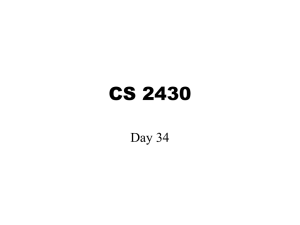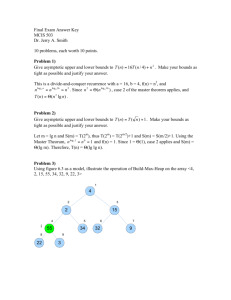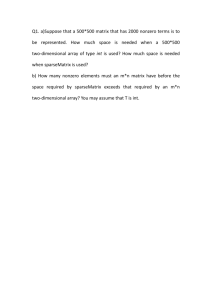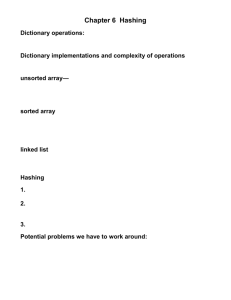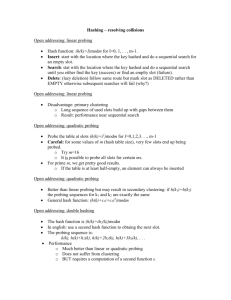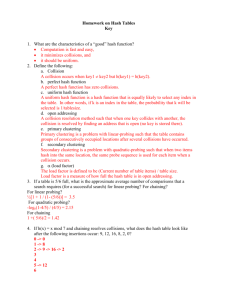Chapter 12 - Philadelphia University
advertisement
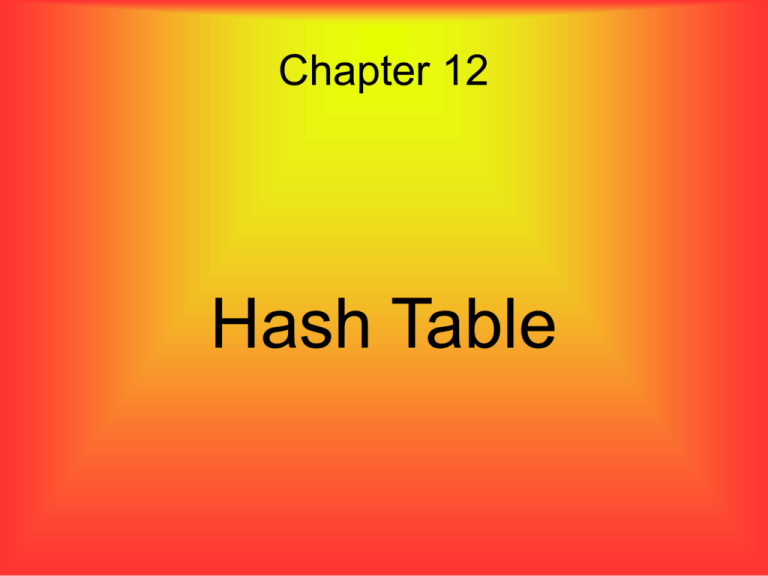
Chapter 12 Hash Table Hash Table ● ● So far, the best worst-case time for searching is O(log n). Hash tables average search time of O(1). worst case search time of O(n). Learning Objectives ● Develop the motivation for hashing. ● Study hash functions. ● ● ● Understand collision resolution and compare and contrast various collision resolution schemes. Summarize the average running times for hashing under various collision resolution schemes. Explore the java.util.HashMap class. 12.1 Motivation ● ● Let's design a data structure using an array for which the indices could be the keys of entries. Suppose we wanted to store the keys 1, 3, 5, 8, 10, with a guaranteed one-step access to any of these. 12.1 Motivation ● The space consumption does not depend on the actual number of entries stored. ● It depends on the range of keys. What if we wanted to store strings? For each string, we would first have to compute a numeric key that is equivalent to it. java.lang.String.hashCode() computes the numeric equivalent (or hashcode) of a string by an arithmetic manipulation involving its individual characters. 12.1 Motivation ● Using numeric keys directly as indices is out of the question for most applications. There isn't enough space 12.1 Motivation 12.2 Hashing ● A simple hash function table size of 10 h(k) = k mod 10 12.2 Hashing ● ● ● ● ear collides with cat at position 4. There is empty space in the table, and it is up to the collision resolution scheme to find an appropriate position for this string. A better mapping function For any hash function one could devise, there are always hashcodes that could force the mapping function to be ineffective by generating lots of collisions. 12.2 Hashing 12.3 Collision Resolution ● There are two ways to resolve collisions. open addressing ● Find another location for the colliding key within the hash table. closed addressing ● store all keys that hash to the same location in a data structure that “hangs off” that location. 12.3.1 Linear Probing 12.3.1 Linear Probing ● ● As more and more entries are hashed into the table, they tend to form clusters that get bigger and bigger. The number of probes on collisions gradually increases, thus slowing down the hash time to a crawl. 12.3.1 Linear Probing ● Insert "cat", "ear", "sad", and "aid" 12.3.1 Linear Probing ● Clustering is the downfall of linear probing, so we need to look to another method of collision resolution that avoids clustering. 12.3.2 Quadratic Probing 12.3.2 Quadratic Probing ● ● ● Avoids Clustering When the probing stops with a failure to find an empty spot, as many as half the locations of the table may still be unoccupied. A hash to 2,3,6,0,7, and 5 are endlessly repeated, and an insertion is not done, even though half the table is empty. 12.3.2 Quadratic Probing ● For any given prime N, once a location is examined twice, all locations that are examined thereafter are also ones that have been already examined. 12.3.3 Chaining ● If a collision occurs at location i of the hash table, it simply adds the colliding entry to a linked list that is built at that location. Running times ● We assume that the hashing process itself (hashcode and mapping) takes O(1). Running time of insertion is determined by the collision resolution scheme. 12.4 The java.util.HashMap Class ● Consider a university-wide database that stores student records. Every student is assigned a unique id (key), with which is associated several pieces of information such as name, address, credits, gpa, etc. These pieces of information constitute the value. 12.4 The java.util.HashMap Class ● ● A StudentInfo dictionary that stores (id, info) pairs for all the students enrolled in the university. The operations corresponding to this relationship can be found in hava.util.Map<K,V> 12.4 The java.util.HashMap Class ● ● The Map interface also provides operations to enumerate all the keys, enumerate all the values, get the size of the dictionary, check whether the dictionary is empty, and so on. The java.util.HashMap implements the dictionary abstraction as specified by the java.util.Map interface. It resolves collisions using chaining. 12.4.1 Table and Load Factor ● ● When the no-arg constructor is used Default initial capacity 16 Default load factor of 0.75. The table size is defined as the actual number of key-value mappings in the has table. 12.4.1 Table and Load Factor ● We can choose an initial capacity Only uses capacities that are powers of 2. ● 101 becomes 128 12.4.1 Table and Load Factor ● An initial capacity of 128. 12.4.2 Storage of Entries ● Relevant fields in the HashMap class. threshold is the size threshold ● Product of the capacity and the threshold load factor (N* t) 12.4.2 Storage of Entries ● Entry[] table sets up an array of chains. Map.Entry<K,V> is defined inside the Map<K,V> interface. next holds a reference to the next Entry in its linked list. 12.4.3 Adding an Entry ● Example Name serves as a key to the phone number value. 12.4.3 Adding an Entry 12.4.3 Adding an Entry ● If the key argument is null, a special object, NULL_KEY is returned, otherwise the argument key is returned as is. 12.4.3 Adding an Entry 12.4.3 Adding an Entry ● Example h = 25 and length = 16 The binary representation of h and length-1 (11001 and 01111). 12.4.3 Adding an Entry ● ● Since length is a power of 2, the binary representation of length will be 100...0 with k zeros. Any h is expressible as 2c * k + r. r is a result of the bit-wise and, since the 2c * k part is a higher order bit that will be zeroed out in the process. 12.4.3 Adding an Entry 12.4.3 Adding an Entry ● The if statement triggers a rehashing process if the size is equal to or greater than the threshold. 12.4.4 Rehashing 12.4.4 Rehashing 12.4.5 Searching 12.5 Quadratic Probing: Repetition of Probe Locations ● ● Quadratic probing only examines N/2 locations of the table before starting to repeat locations. Suppose a key is hashed to location h, where there is a collision. Following locations are examined. 12.5 Quadratic Probing: Repetition of Probe Locations ● If two different probes (i and j) end up at the same location? 12.5 Quadratic Probing: Repetition of Probe Locations ● ● ● ● Since N is a prime number, it must divide one of the factors (i + j) or (i - j). N divides (i - j) only when at least N probes have been made already. N divides (i + j) when (i + j = N), at the very least. j=N-i 12.6 Summary ● ● A hash table implements the dictionary operations of insert, search, and delete on (key, value) pairs. Given a key, a hash function for a given hash table computes an index into the table as a function of the key by first obtaining a numeric hashcode, and then mapping this hashcode to a table location. 12.6 Summary ● ● ● When a new key hashes to a location in the hash table that is already occupied, it is said to collide with the occupying key. Collision resolution is the process used upon collision to determine an unoccupied location in the hash table where the colliding key may be inserted. In searching for a key, the same hash function and collision resolution scheme must be used as for its insertion. 12.6 Summary ● ● ● A good hash function must be O(1) time and must distribute entries uniformly over the hash table. Open addressing relocates a colliding entry in the hash table itself. Closed addressing stores all entries that hash to a location, in a data structure that “hangs off” that location. Linear probing and quadratic probing are instances of open addressing, while chaining is an instance of closed addressing. 12.6 Summary ● ● Linear probing leads to clustering of entries with the clusters becoming increasingly larger as more and more collisions occur. Clustering degrades performance significantly. Quadratic probing attempts to reduce clustering. On the other hand, quadratic probing may leave as many as half the hash table empty while reporting failure to insert a new entry. 12.6 Summary ● ● ● Chaining is the simplest way to resolve collisions and also results in better performance than linear probing or quadratic probing. The worst-case search time for linear probing, quadratic probing, and chaining is O(n). The load factor of a hash table is the ratio of the number of keys, n, to the capacity, N. 12.6 Summary ● The average performance of chaining depends on the load factor. For a perfect hash function that always distributes keys uniformly, the average search time for chaining is O(1).

